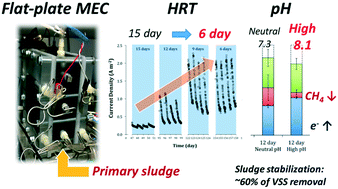Maximizing Coulombic recovery and solids reduction from primary sludge by controlling retention time and pH in a flat-plate microbial electrolysis cell†
Abstract
Anaerobic digestion (AD) is a mature anaerobic biotechnology that plays a significant role in wastewater treatment in terms of solids reduction and energy recovery as methane. An alternative anaerobic platform, the microbial electrochemical cell (MXC), has shown similar results to AD in terms of solids reduction, but electron recovery as electrical current has been poor, in large part because of undesired production of methane. The aim of this study was to maximize Coulombic recovery (CR) and minimize methanogenesis by controlling the anode hydraulic retention time (HRT) and pH in a flat-plate microbial electrolysis cell (MEC) fed semi-continuously with primary sludge (PS). Although the PS-fed MEC had ∼60% solids reduction for all HRTs tested (6 to 15 days), the HRT had a strong impact on current density and CR. The maximum current density was >2 A m−2 for 6 and 9 day HRTs, while CR was the highest (34%) for a 9 day HRT. A relatively high pH (∼8.1) in the anode chamber also led to an increase in CR by suppressing methanogenesis. Being the first report of long-term MEC operation with PS, this study demonstrates that CR and sludge treatment can be improved by increasing pH and decreasing HRT in a flat-plate MEC.



 Please wait while we load your content...
Please wait while we load your content...